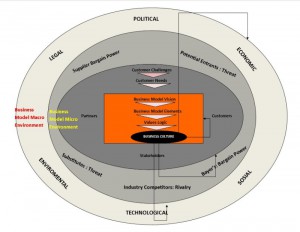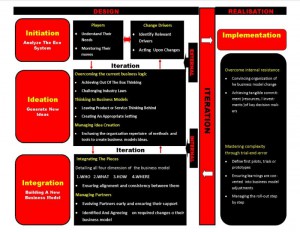‘‘How will organizations deliver revenue growth in an increasingly competitive and fast-changing business environment? How will they optimize their cost structures while offering more value to their customers? And how must they position themselves in the global value chain to differentiate their organizations and create a sustainable competitive advantage?”
These questions are driving companies today, across a range of industries, to radically rethink their business model as it affects their performance.
Three decades ago strategy was the primary building blog of competitiveness (competitive advantage) but today, due to globalization, the economic slowdown in the developed economies and the efforts to enter the emerging markets, the interest has shifted widely to the development of an innovative business model. Nevertheless, not all companies are able to generate successful business models and the success depends on how their model interacts with their competitors. Most of the times the business model has a very short life cycle because it is similar to the model of other members in the same industry or it is failing to keep up with evolution in the market or, otherwise, the short life cycle is due to management failures.
As a consequence product innovation or technology itself is no longer a viable source of a competitive advantage for companies. Today, competitors are able to quickly replicate product innovations and even the most innovative products rapidly become obsolete due to increasingly shorter life cycles. Innovation does not only mean the development of new products or new top technologies any longer, but it also means innovative business models aiming to address the unsatisfied group of consumers or unsatisfied needs of the consumers, to provide new or different benefits from the application of products and services or to deliver values to the consumers in a new and unconventional way.
The Increasing Importance of Business Model Innovation
A recently published report from the Economist Intelligence Unit found that a majority of the over 4,000 senior managers who were surveyed worldwide favored new business models over new products and services as a source of future competitive advantages. The report stated that, “the overall message is clear: how companies do business will often be as, or more, important than what they do”. And in a similar study conducted by IBM, in which over 750 corporate and public sector leaders from around the world were interviewed on the subject of innovation, “one key finding was that competitive pressures have pushed business model innovation much higher than expected on CEOs’ priority list”. Indeed, the study found that out-performing companies whose operating margins had grown faster than their competitors over the previous five years, were twice as likely as their lower-performing peers to emphasize business model innovation as opposed to product or process innovation. One CEO explained the importance of business models as a source of innovation by contrasting it with process innovation:
“In the operations area, much of the innovations and cost savings that could be achieved have already been achieved. Our greatest focus is on business model innovation, which is where the greatest benefits lie. It’s not enough to make a difference on product quality or delivery, readiness or production scale. It’s important to innovate in areas where our competition does not act – by developing new competencies, alliances, etc”.
Slowly but steadily “innovation” in business models has become the hottest word in business, although most of the discussion centers on products and services. The more profound challenge for most companies now is imagining a new business model, a new answer to the fundamental question “how do we make money?”.
And that is exactly the point where the question arises: How can an organization create a business system that could rapidly understand changes and adjust the corporate mechanism in such a way as to create a competitive advantage, staying close to customer needs and being profitable?
While academics have focused on specific examples of successful business model innovation, consultancies have tried to extrapolate the findings to a larger population. Donald Mitchell and Carol Coles of Mitchell and Company conducted an empirical study (2003) on 100 public companies and concluded that the most successful companies were the ones making frequent and fundamental changes to their business model. In addition, a joint study by Business Week and the Boston Consulting Group examined the performance of a sample of 50 major companies and concluded that business model innovators have higher returns than product or process innovators and that they are able to sustain them over longer time periods (Lindgardt et al., 2009).
Peter Drucker has noted that: “sloughing off yesterday is almost impossibly difficult, yet every organization must get used to doing it regularly. The largest obstacles will be weak imaginations, threatened interests, and culture. Business-model innovation is the new essential competency. It’s hard. It will separate tomorrow’s winners from the losers.”
The business model concept consists of the following basic different components:
- Value proposition: describes products and services that create value for a customer segment
- Customer segment: defines different groups of people or organizations that a company aims to reach and serve
- Channels: describe how a company communicates with and reaches its customer segments to deliver products and services
- Customer relationships: describe the types of relationships a company establishes with customers
- Revenue streams: this is cash a company generates from each customer segment
- Key resources: most important assets required to make a business model work
- Key activities: describe the most important activities a company needs to engage in to make its business model work
- Key partnerships: network of suppliers and partners that make the business model work
- Cost structure: all costs incurred to operate a business model
In order to build an effective business model one has to seriously consider the business model environment which we define as follows:
“The business model environment separates into the macro and micro environment. The macro environment identifies future drivers in the following dimensions: political, economic, social, technological, environmental and legal. The micro environment identifies the following market forces from a customers´ perspective: bargaining power of suppliers, threat from substitutes, rivalry among competitors, bargaining power of buyers and threat from potential entrants. The customers, partners and stakeholders are also part of the micro environment. The macro and micro environment influence customer challenges and needs that is a basis for the development of a business model.”
For creating a business model, companies must also proceed to Policy Choices, Accept Choices and government choices.

Magretta defines business models as “stories that explain how enterprises work”. Peter Drucker gave the definition of the business model as the answers to the following questions: Who is the customer, what does the customer value and how do you deliver value at an appropriate cost?
According to Mitchel and Coles, changing a single business model component in a way to enhance the company against competitors is a business model improvement; changing at least four components of a business model is a business model replacement; a business model replacement not previously available in the industry is a business model innovation (Mitchel and Coles, 2003). Thus, a business model innovation is a substantial change of at least four elements of the business model canvas in a configuration not seen before in the industry.
Designing a new business model requires creativity, insight, and a good deal of customer, competitor and supplier information and intelligence. There may be a significant tacit component. An entrepreneur may be able to intuit a new model but not be able to rationalize and articulate it fully; so experimentation and learning is likely to be required.
The conclusion seems clear. Management science is pointing towards the direction of declaring business model innovation as a source of competitive advantage and officially considering Porter’s resource based theory outdated for the digital age.
There is often a misunderstanding among business people regarding Model, Strategy and Tactics which are interrelated and this misunderstanding can lead to wrong decision making. Business Models refer to the logic of the company—how it operates and creates and captures value for stakeholders in a competitive marketplace. Strategy is the plan to create a unique and valuable position involving a distinctive set of activities. Tactics are a set of possible or available actions to compete in the marketplace. Strategy focuses on building competitive advantage by defending a unique position or exploiting a valuable and idiosyncratic set of resources. These positions and resources are created by virtuous cycles, so executives should develop business models that activate these cycles.
In essence, a business model embodies nothing less than the organizational and financial ‘architecture’ of a business. Regardless of the sector, there are criteria that enable one to determine whether or not one has designed a good business model. A good business model yields value propositions that are compelling to customers, achieves advantageous cost and risk structures, and enables significant value capture by the business that generates and delivers products and services. ‘Designing’ a business correctly, and figuring out, then implementing and then refining commercially viable architectures for revenues and costs are critical to enterprise success. The above are essential when the enterprise is first created; but keeping the model viable is also likely to be a continuing task. Superior technology and products, excellent choice of people, and good governance and leadership are unlikely to produce sustainable profitability if the business model configuration is not properly adapted to the competitive environment.
Whenever a business enterprise is established, it either explicitly or implicitly employs a particular business model that describes the design or architecture of the value creation, delivery, and capture mechanisms it employs. The essence of a business model is in defining the manner by which the enterprise delivers value to customers, entices customers to pay for value, and converts these payments into profit. It thus reflects the management’s hypothesis about what customers want, how they want it, and how the enterprise can organize to best meet these needs, get paid for doing so, and make a profit.
An innovative business model could help organizations to address downturn-specific opportunities, enabling companies, for example, to lower their prices or reduce the risks and costs of ownership for customers. As data shows , the companies that flourish in downturns frequently do so by leveraging the crisis to reinvent themselves—rather than by simply deploying defensive financial and operational tactics.
Phases of the business model innovation process and their key challenges

Moreover, during times of crisis, companies often find it easier to gain consensus around the bold moves required to reconfigure an existing business. Business model innovation is more challenging than product or process innovation, but it also delivers superior returns. Recent surveys by Boston Consulting Group and BusinessWeek showed that while both types of innovators achieved a premium over the average total shareholder return for their industries, business model innovators earned an average premium that was more than four times greater than that enjoyed by product or process innovators.
Furthermore, organizations that applied more innovative business models delivered returns that were more sustainable; even after ten years, business model innovators continued to outperform competitors and product and process innovators.
Many companies pursue business model innovation as a defensive move to protect a dying core business or to defend against aggressive competitors. But we are convinced that business model innovation can be most powerful when it is approached proactively to explore new avenues of growth.
As Fortune described in a relevant article:
“Not since the Industrial Revolution have we seen a longer or broader list of companies whose business models are suddenly obsolete. Start with virtually all companies in the media business, or any company that relies on owning copyrights or selling advertising. Then look at major retailers. The whole education industry needs a new model. So do banking, the post office, computer makers, Big Pharma, music, and the telecoms. They all need new business models, and almost all are having a hard time finding them. That’s because business-model innovation is a competency that doesn’t exist in most companies. It never had to.
For example, the newspaper business model worked great for 200 years. Twenty generations of management didn’t have to change it. Why should we expect that today’s generation would know how it’s done? Additionally….we can’t count how many business models Amazon has used in its 18 years of existence. The model is changing continually”.
Why Do Many Business Models Fail?
On an international level many organizations are failing to develop a new business model as they are simply trying to apply the same model in different countries without considering the different social and economic conditions.
Another reason is that many organizations have become cumbersome and cannot rapidly adapt to market changes nor proceed quickly and successfully to a necessary internal transformation. Small and medium size businesses can more easily shift their “business course” and make the necessary business model adjustments. Of course all the above are affected by international or national regulations and polices.
As the Guardian reports in a recent article:
“Companies fail at business model innovation because they’re so busy pedaling the bicycle of current business models they leave no time or resource to design new ones. Most companies focus innovation efforts on new products and on driving efficiencies into current models. These are important activities, but not sufficient in the 21st century when business models don’t last as long and face disruption. This means business model innovation is the new strategic imperative”.
In this post I also outline the top 10 reasons why businesses fail to innovate. The most common reason of failing are:
- CEOs don’t really want a new business model
- Business model innovation will be the next CEO’s problem
- Product is king – nothing else matters
- Information technology is only about keeping the trains moving and lowering costs
- Cannibalization is off the table
- Nowhere near enough connecting with unusual suspects
- Line executives hold your pay card
- Great idea, what’s the ROI?
- They shoot business model innovators, don’t they?
- You want to experiment in the real world, are you crazy?
For any one company, business model innovation for sustainability will derive from a confluence of three key factors: evolving external conditions; the company’s underlying culture and capacity to innovate; and the actions and intentions of the sustainability innovator.
The companies and innovators that focus on these factors will create business models that can initiate and thrive in a more sustainable future. This will require ambitious leadership from inside companies: both CEOs and individual sustainability innovators must stick their necks out to create and support a vision of what a new business model might look like.
The Questions Managers Need to Ask for Business Model Innovation
Innovation need not simply be about new product lines or improved processes, but can also relate to the organization of a firm’s activities, specifically, their content, structure and governance.
Indeed, our own research shows that in a highly interconnected world, especially in a world where financial resources are scarce, entrepreneurs and managers must look beyond the product and process levels to focus on ways to innovate their business model. This can help them create and exploit opportunities for new revenue and profit streams to counteract declining revenues and pressures on profit margins and position themselves for the next economic upturn. In this regard, we suggest that managers ask themselves the following six key questions:
- What is the objective of the new business model? In other words, what perceived needs would be satisfied through the design of a new activity system?
- What novel activities are needed to satisfy the perceived needs? (Business model content.)
- How could these activities be linked to each other in novel ways? (Business model structure.)
- Who should perform each of the activities that are part of the business model (e.g., the focal firm, or a partner), and what novel governance arrangements could enable this structure? (Business model governance.)
- How is value created through the novel business model for each of the partners?
- What focal firm’s revenue model will allow it to appropriate part of the value created from the new business model?
Every company aiming to build a successful business model innovation should create the necessary prerequisites for a successful one. In essence, it is first about establishing a culture that promotes innovation. An innovation-promoting culture distinguishes itself by intensive, cross-functional communication, creativity, error tolerance and entrepreneurial willingness to take risks promoting ideas and designing the necessary structures for realizing the innovation’s potential.
*Download Business Model Innovation in PDF Form







Leave A Comment